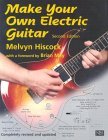Make Your Own Electric Guitar – A Review

If guitar building is in your future, Make Your Own Electric Guitar by Melvyn Hiscock is one of the very best books on the subject. Hiscock tackles all the important aspects of guitar construction – design, building the guitar neck and body, wiring pickups and controls, basic finishing, wood choices and tools – through black and white photographs and a relaxed writing style that any budding luthier can understand.
The first several chapters are an excellent overview of the basic choices in making your own electric guitar. Do you want a bolt on neck like a Fender or a set neck like a Gibson? What neck scale do you want? Should you go with a fixed bridge or a tremolo bridge? What woods should use for the body and neck?
The next four chapters take you through a Strat style guitar, a Tele style guitar, an eight string bass and thoughts on designing your custom guitar by combining elements from these different types.
With the basic guitar complete, the remaining chapters cover finishing your guitar, electronics and guitar setup.
Now in its second edition, there isn’t much to fault in this bible for electric guitar makers. Nevertheless, I would like to suggest a few things. While the black and white photos are good, there’s no substitute for color photos. Also, the sample guitar builds should go beyond variations of Fender inspired designs. Finally, I’d welcome coverage of newer guitar parts, construction materials and designs. In particular, I’d like to see headless guitar coverage and the use of composite materials (think Parker Guitars).
My suggestions aside, Hiscock’s Make Your Own Electric Guitar is a thorough, informative and even entertaining resource for the up and coming electric guitar builder. You’ll learn what questions to ask, what problems to anticipate and be well on your way to designing and building your own guitar.
I’m surprised no one has commented on this book yet. I own it and it is a great book. I think it is the most informative book on the topic. It doesn’t include a lot of ideas on ergonomic designs but it does talk about designing your own instruments and gives you guidance in that direction.
Agreed! It’s a phenomenal resource – clear, concise and thorough.
You’re absolutely right about it lacking information on ergonomic designs but I’m doing my best to fill some of that gap. 🙂
[…] You can read the rest of this blog post by going to the original source, here […]